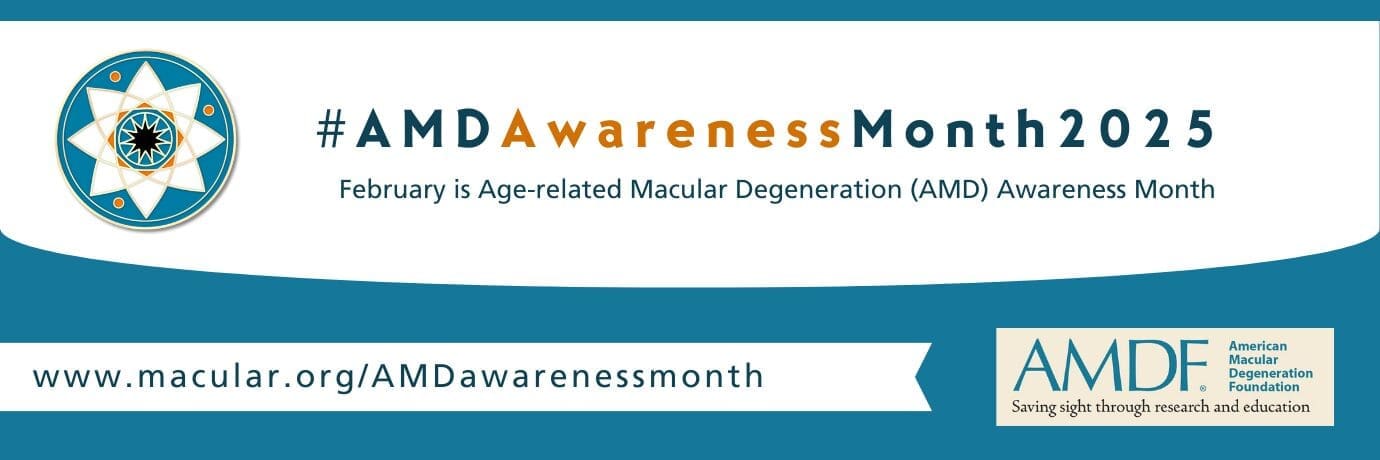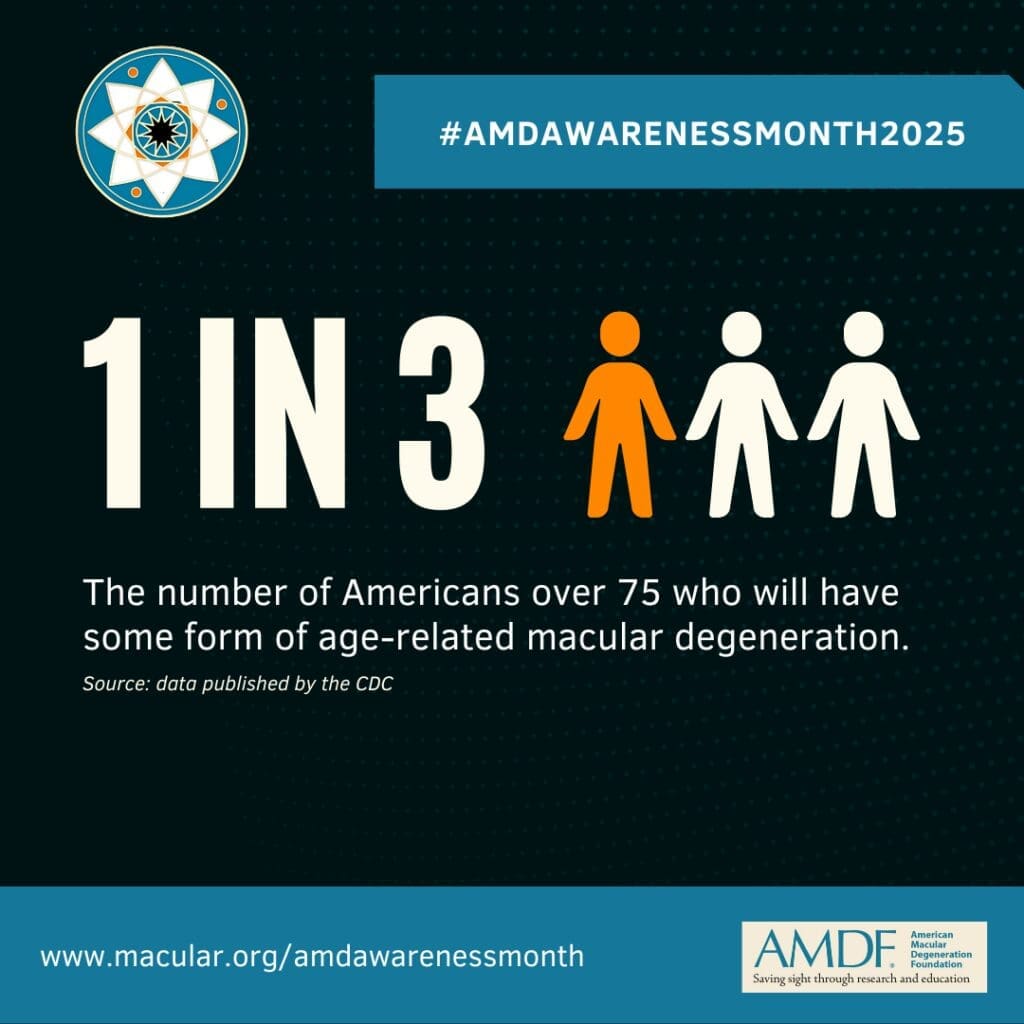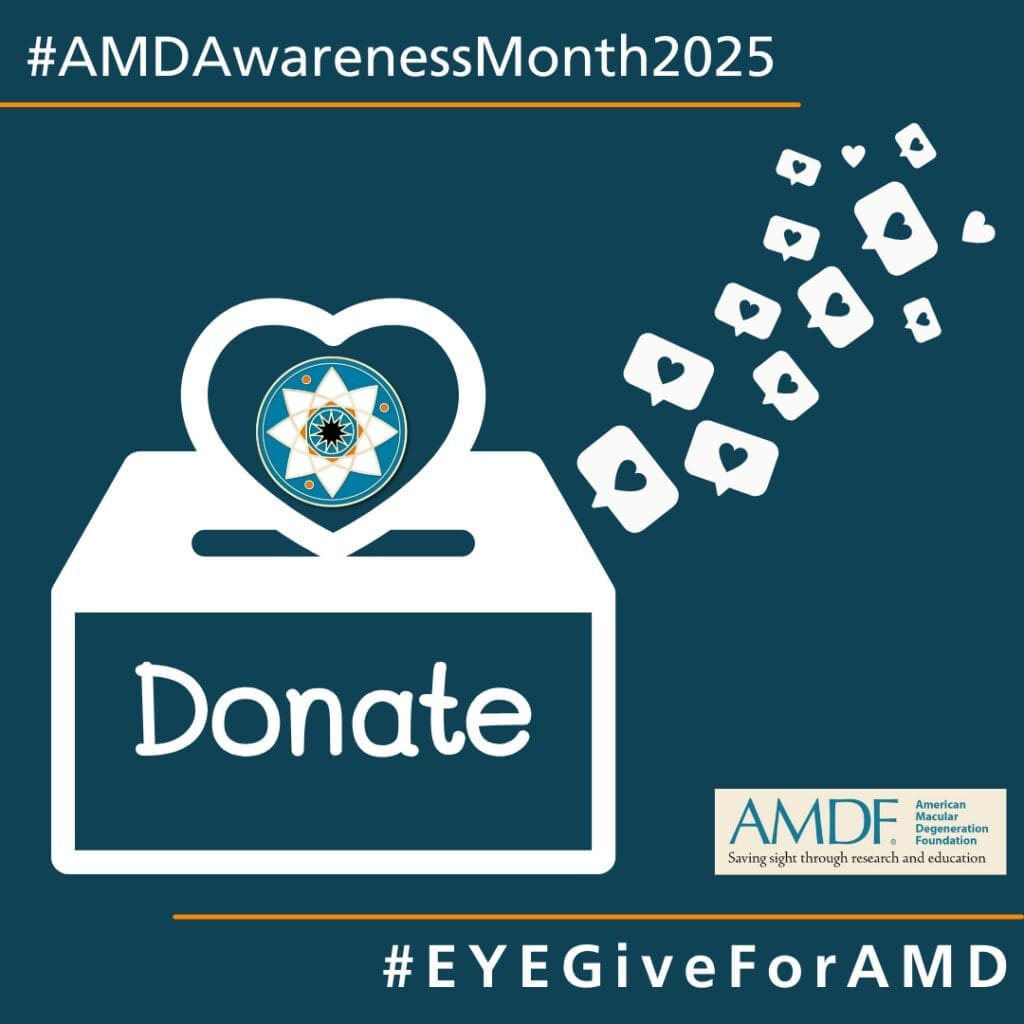
AMD Awareness Month, sometimes also referred to as AMD and Low Vision Awareness Month, was established in 2008 to raise awareness about the national prevalence and impact of age-related macular degeneration (AMD) on individuals, and the rippling effect on their networks of care.
In 2025, the state of AMD in the United States remains alarming.
The State of Age-Related Macular Degeneration in 2025
According to the most recent data published by the CDC:
Prevalence in the United States
- Nearly 20 million Americans aged 40+ have been diagnosed with some form of macular degeneration.
- 1.49 million Americans are living with a late-stage vision-threatening form of age-related macular degeneration. This is about 22% of the total 7 million Americans living with vision loss or blindness.

By the age of 75, roughly 1 in 3 people living in the United States will have some form of age-related macular degeneration, and about 1 in 4 of those will have a vision-threatening, late-stage form of AMD.
Learn More About Macular Degeneration
Click here to learn more about age-related macular degeneration.
Join the Action and Stay Informed Through February
AMDF has content releases planned throughout the month of February with a focus for each week:
- Week 1 – AMD Early Detection, Risk Reduction, and Intervention
- Week 2 – AMD Vision Loss Impact on Daily Life
- Week 3 – AMD Mind and Brain
- Week 4 – Access in Sight! AMD Advocacy and Action Week
Bookmark this page and check back in each week. You can also follow us on Facebook, X (formerly Twitter), and join our free email list below (scroll to the bottom of the page) to get updates.
EARLY DETECTION, RISK REDUCTION, AND INTERVENTION
There is no cure for age-related macular degeneration, but early detection, along with lifestyle changes and treatments, can help preserve vision for as long as possible for those at risk of developing AMD.
Time is Vision
Early detection for the onset of all types of age-related macular degeneration is key to preserving vision for as long as possible. For Dry AMD, an early diagnosis means opportunities to reduce risk, delay onset, or slow progression of vision loss through lifestyle changes and supplements.
For wet AMD onset, time is even more critical. Research indicates that the earlier you start receiving anti-VEGF treatments the better your outcome is likely to be (one recent study suggests within the first 48 hours of onset1). In fact, an AMDF-supported study is showing that time-to-treatment may be the most important factor in preserving your vision.

Don’t wait if you notice a sudden change in your vision such as sudden dark spots, blurriness, or straight lines appearing bent or wavy. Call your eye specialist right away if you suspect the onset of wet macular degeneration.
*Right-click, or drag-and-drop this graphic to save and share to your social media to help us spread awareness about this important issue.
Laura Carabello knew she was at risk of developing macular degeneration, and when she had a sudden change to her vision, she knew she needed treatment right away. She credits awareness, monitoring, immediate intervention, and treatment adherence with preserving her vision for longer. Watch this short video to learn more about Laura’s story.
Controllable Risk Factors for Age-related Macular Degeneration
The causes of AMD are complex, but several risk factors are controllable through lifestyle changes.
- Smoking – Smoking doubles the risk of AMD, and recent studies have found that living in an air-polluted environment also increases risk
- Diet – a poor diet, high in saturated fats and cholesterol and low in antioxidants, can increase risk for AMD and accelerate its progression
- Unchecked cardiovascular disease or high blood pressure
- Weight – being overweight overall, but particularly around the abdomen
- Sun exposure without eye protection
Non-controllable Risk Factors for Age-related Macular Degeneration
Some risk factors of AMD are not under anyone’s control.
- Age – the risk of developing AMD begins increasing by age 40, and exponentially increases after the age of 75.
- Genetics – a family history of macular degeneration.
- Light colored irises.
- Far-sightedness
- Being female – understood to be because women usually live longer than men.
Reducing Risk and Early Intervention for AMD
The two actions you can take if you are at risk for age-related macular degeneration are to change any lifestyle factors that put you more at risk, and to monitor your vision through regular eye exams and at home so you can detect any vision-emergency changes.
The standard to monitor your vision at home is the Amsler Grid. Click here for a free, downloadable Amsler Grid with instructions.
AMDF also offers copies of the KeepSight Journal, which studies have shown is a highly effective way to help you keep track of your vision and any changes.
For free recipes to inspire you to eat healthier for your eyes and macular degeneration, see our library of free AMD Diet recipes.
AMD VISION LOSS – IMPACT ON DAILY LIFE
It is estimated that roughly 1.5 million Americans have a vision-threatening form of age-related macular degeneration and another 30,000 to 200,000 live with Stargardt’s, the inherited form of macular degeneration.
Vision loss can be gradual, or sudden, but either way, there is no question that vision loss can have a profound impact on daily living for those affected. The impacts are wide-ranging, from emotional impact to effects on independence and quality of life.
In 2023, AMDF released the award-winning documentary, Losing Sight, Finding Hope: Living with Macular Degeneration to offer information, and hope, to people at all stages of macular degeneration. So far, the film has reached nearly 50,000 viewers.
Impact of vision loss on daily life can include all the obvious things, like not being able to drive, but it’s the accumulation of minor and major things that can rob a person of a sense of well-being and independence. Things like:
- Difficulty with practical reading, such as signs, food labels, receipts, menus, etc.
- Difficulty with hobbies that require close detail
- Difficulty navigating new environments
- Difficulty recognizing faces, even of their own family and friends
- Increased isolation
- Increased risk of falls and injuries due to balance issues or not being able to detect walking hazards
- Lack of access to transportation
- Economic burden of treatments
- and so much more
AMD UNDERSERVED COMMUNITIES
While AMD is most prevalent in caucasians, other races/ethnicities are still at risk!
- Black (non-hispanic) 1,230,000 with AMD and 88,000 with vision-threatening form (CDC)
- Hispanic 2,111,000 with AMD and 51,000 with vision-threatening (CDC)
- Other race/ethnicity 1,199,000 with AMD and 93,000 with vision-threatening (CDC)
- Racial Differences in AMD Longitudinal Study https://www.ncbi.nlm.nih.gov/pmc/articles/PMC3143259/
- Impact of Race Inequities in Health Care https://www.aao.org/senior-ophthalmologists/scope/article/impact-of-race-inequities-in-eye-health-care
- White people receive more macular degeneration treatment https://www.medscape.com/viewarticle/973605?form=fpf
Income and education can also affect access to treatment and visual acuity outcomes!
- Regardless of ethnicity, people with lower income are less likely to visit an eye doctor https://www.nature.com/articles/s41433-021-01567-1
- This UK study found poorer baseline visual acuity among people with wet AMD from more deprived areas. https://www.ncbi.nlm.nih.gov/pmc/articles/PMC7005865/
- Barriers to care in neovascular age-related macular degeneration – In summary, we found that the most common barriers to nAMD care reported were related to travel, psychological factors, and financial burden on patients and their caregivers. https://www.sciencedirect.com/science/article/abs/pii/S0039625723001157
- Improving access to care, a systematic review of the literature https://www.sciencedirect.com/science/article/pii/S0161642022005309
JOIN US IN RAISING AWARENESS ABOUT AGE-RELATED MACULAR DEGENERATION

Wear the AMD Awareness Pin in February.
Join thousands of people wearing the AMD Awareness Pin in February, available through any level of donation. Learn more here.
Share this graphic on your social media.
Right click to save, or drag and drop. Share to your social media and tell your macular degeneration story. Use the hashtags #amdawarenessmonth2025 and #AMDF and tag us on Facebook


Host a Fundraiser on Facebook!
Raise awareness and funds by hosting a fundraiser on Facebook to benefit AMDF and our mission to empower the AMD community through research funding, education, awareness, and advocacy.

